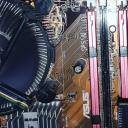AMD Instinct MI300 an APU with 24 Zen 4 cores, CDNA 3 GPGPU cores, and 128GB of HBM Ram on die. Say Goodbye To PC Building as we've known it.
-
Featured Topics
-
Topics
-
CDR_Xavier ·
Posted in Build Logs0 -
McBeth1087 ·
Posted in New Builds and Planning2 -
4
-
NamelessUser ·
Posted in Troubleshooting1 -
HereWeGo ·
Posted in Power Supplies2 -
Ariolander ·
Posted in Linux, macOS and Everything Not-Windows3 -
0
-
MorbidlyOBeast ·
Posted in Troubleshooting1 -
2
-
2
-

















Create an account or sign in to comment
You need to be a member in order to leave a comment
Create an account
Sign up for a new account in our community. It's easy!
Register a new accountSign in
Already have an account? Sign in here.
Sign In Now